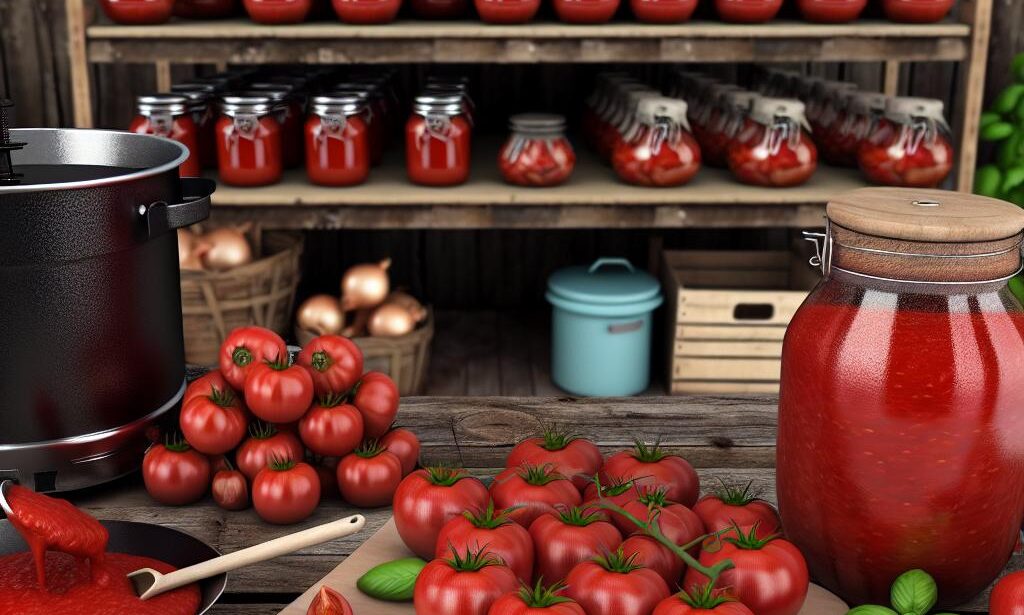Tomato sauce is a staple in many kitchens, adding flavor and depth to a variety of dishes. Whether you prefer a simple marinara or a rich bolognese, knowing how to preserve classic tomato sauce can ensure you have a supply on hand year-round. In this guide, we will explore the best methods for preserving tomato sauce so you can enjoy the taste of summer tomatoes no matter the season.
Table of Contents
- Choosing the Right Tomatoes for Sauce Making
- Best Practices for Canning Tomato Sauce
- Storing Tomato Sauce for Long-Term Preservation
- Tips for Enhancing Flavor and Shelf Life of Tomato Sauce
- Q&A
- Key Takeaways
Choosing the Right Tomatoes for Sauce Making
When it comes to making a classic tomato sauce that can be enjoyed year-round, choosing the right tomatoes is essential. Not all tomatoes are created equal, and some varieties are better suited for sauce making than others. Here are some tips to help you select the best tomatoes for your sauce:
- Roma Tomatoes: Known for their meaty texture and low moisture content, Roma tomatoes are a popular choice for sauce making. They have fewer seeds and less juice, making them ideal for creating a thick and flavorful sauce.
- San Marzano Tomatoes: Hailing from Italy, San Marzano tomatoes are prized for their sweet flavor and low acidity. They are often used in traditional Italian sauces and are a favorite among chefs for their rich taste.
- Heirloom Tomatoes: While heirloom tomatoes come in a variety of shapes, sizes, and colors, they are all known for their exceptional flavor. They can add a unique and complex taste to your sauce, making it stand out from the rest.
| Tomato Variety | Best Used For |
|---|---|
| Roma Tomatoes | Thick and flavorful sauces |
| San Marzano Tomatoes | Traditional Italian sauces |
| Heirloom Tomatoes | Unique and complex flavors |
By choosing the right tomatoes for your sauce, you can ensure that it turns out delicious and full of flavor. Experiment with different varieties to find the perfect combination that suits your taste preferences. Whether you prefer a classic marinara or a spicy arrabbiata, the type of tomatoes you use can make all the difference in creating a sauce that will be enjoyed throughout the year.

Best Practices for Canning Tomato Sauce
When it comes to preserving classic tomato sauce, following best practices for canning is essential to ensure a safe and delicious end product. Here are some tips to help you successfully can tomato sauce:
- Use fresh, ripe tomatoes: The quality of your tomato sauce starts with the tomatoes themselves. Choose ripe, flavorful tomatoes for the best results.
- Properly sterilize jars: Before filling your jars with tomato sauce, make sure they are thoroughly cleaned and sterilized to prevent any contamination.
- Add acid: To ensure the safety of your canned tomato sauce, it’s important to add acid in the form of lemon juice or citric acid. This helps to prevent the growth of harmful bacteria.
| Ingredient | Amount |
|---|---|
| Tomatoes | 10 lbs |
| Lemon juice | 1/4 cup |
| Salt | 1 tbsp |
By following these best practices and using fresh, quality ingredients, you can enjoy delicious homemade tomato sauce year-round. Whether you’re making a large batch to stock your pantry or just preserving a few jars for later, canning tomato sauce is a rewarding and practical way to enjoy the flavors of summer all year long.

Storing Tomato Sauce for Long-Term Preservation
When it comes to preserving classic tomato sauce for long-term storage, there are several methods you can use to ensure that you have delicious sauce on hand year-round. One popular method is canning, which involves sealing the sauce in jars and processing them in a water bath or pressure canner. This method is great for preserving large batches of sauce and can be stored in a cool, dark place for up to a year.
Another option for storing tomato sauce is freezing. Freezing is a quick and easy way to preserve sauce, and it can last in the freezer for up to six months. To freeze tomato sauce, simply pour it into freezer-safe containers or bags, leaving room for expansion, and store it in the freezer until you’re ready to use it. Just be sure to thaw the sauce in the refrigerator before reheating.

Tips for Enhancing Flavor and Shelf Life of Tomato Sauce
When it comes to preserving the classic flavor of tomato sauce, there are a few key tips to keep in mind. By following these suggestions, you can enhance both the taste and shelf life of your homemade sauce.
One way to boost the flavor of your tomato sauce is to add fresh herbs and spices. Consider incorporating ingredients like basil, oregano, garlic, and red pepper flakes to give your sauce a delicious kick. These additions not only enhance the taste but also help to preserve the sauce for longer periods of time.
Another tip for extending the shelf life of your tomato sauce is to properly store it. Make sure to seal your sauce in airtight containers or jars before refrigerating or freezing. This will help prevent spoilage and maintain the freshness of your sauce for months to come.
Q&A
Q: Why is it important to preserve tomato sauce?
A: Preserving tomato sauce allows you to enjoy the taste of fresh tomatoes year-round and reduces food waste.
Q: What are the best methods for preserving tomato sauce?
A: Canning, freezing, and drying are popular methods for preserving tomato sauce.
Q: How long can preserved tomato sauce last?
A: When properly stored, canned tomato sauce can last up to 1 year, frozen tomato sauce can last up to 6 months, and dried tomato sauce can last up to 1 year.
Q: What are some tips for making tomato sauce last longer?
A: Using proper canning techniques, storing in a cool, dark place, and labeling with the date of preservation can help extend the shelf life of tomato sauce.
Q: Can I use preserved tomato sauce in recipes that call for fresh tomatoes?
A: Yes, preserved tomato sauce can be used in place of fresh tomatoes in many recipes, such as pasta sauces, soups, and stews. Just adjust the amount of liquid in the recipe accordingly.
Key Takeaways
In conclusion, preserving classic tomato sauce is a simple and rewarding process that allows you to enjoy the flavors of summer all year round. By following the steps outlined in this guide, you can ensure that your homemade sauce stays fresh and delicious for months to come. Whether you choose to can, freeze, or dehydrate your sauce, the key is to use high-quality ingredients and proper techniques to maintain its quality. With a little time and effort, you can stock your pantry with delicious tomato sauce that will enhance your favorite dishes throughout the year. Happy preserving!

